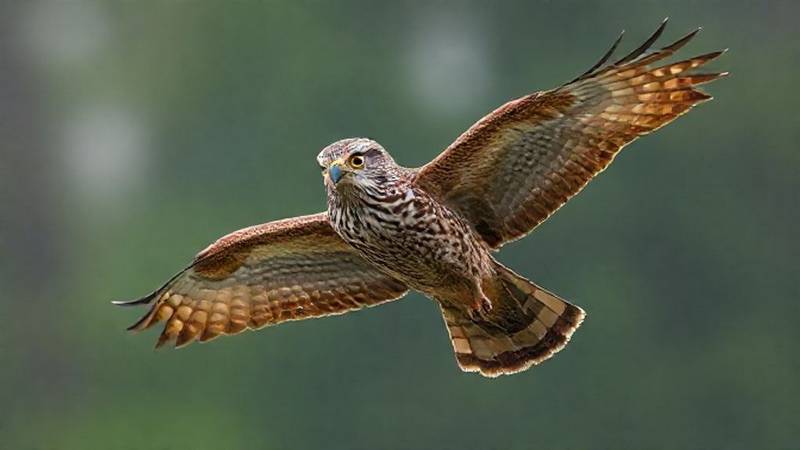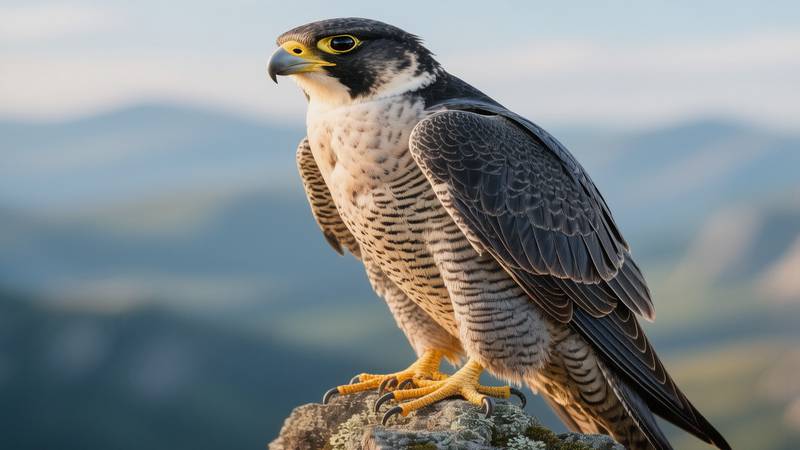Calls and Vocalizations: Discreet but Characteristic
The Common Kestrel is generally a discreet bird. It does not produce melodic songs like passerines, but rather alarm or contact calls. Its most frequent vocalization is a sharp and rapid "kee-kee-kee-kee," which can be repeated several times. This call is often emitted in flight, particularly as an alarm or to mark its territory.
Near the nest, calls are softer and may include more subtle "vrou-vrou" sounds, while young kestrels emit insistent whistling calls to demand food from their parents.
Behavior: The Hovering Hunter
The Common Kestrel is a diurnal and territorial predator, often observed alone or in pairs during the breeding season. It is primarily sedentary throughout most of its range, although northern populations may migrate to warmer regions in winter.
Its hunting technique is very distinctive: it is famous for its "kestrel-hover" or stationary flight. It remains motionless in the air, rapidly beating its wings, with its tail fanned out and pointed downwards, all while meticulously scanning the ground with excellent visual acuity. Once prey is spotted, it dives with precision to capture it with its talons.
Its diet is opportunistic but mainly consists of small rodents, particularly voles and mice, which make up the bulk of its diet in agricultural areas. It also consumes a large quantity of large insects such as grasshoppers, crickets, and beetles, especially in summer. Small birds, lizards, and earthworms may also supplement its menu.
The breeding season begins in spring. The Common Kestrel does not build its own nest. It uses existing cavities: tree hollows, cliff crevices, old woodpecker holes, or abandoned nests of corvids (crows, magpies). In urban environments, it adapts by nesting in ledges, towers, steeples, or even window boxes on balconies. The female typically lays 3 to 6 eggs, incubated mainly by the female for about 27 to 29 days. Young leave the nest after 27 to 32 days but remain dependent on their parents for food for several weeks after their first flight.
Habitat and Distribution
The Common Kestrel (Falco tinnunculus) is an extremely adaptable raptor and one of the most widely distributed in the world. Its range covers a large part of Europe, Asia, and Africa.
It occupies a wide variety of habitats, favoring open areas where it can hunt efficiently. It is frequently found in grasslands, cultivated fields, heathlands, forest edges, parks, and even urban and suburban environments. It requires open areas for its characteristic hunting flight, but also perches (trees, poles, cliffs, buildings) to observe its prey.
Northern European and Asian populations are migratory, wintering in warmer southern regions. Populations in Southern Europe, Africa, and Asia are generally sedentary.
Distribution Map
Conservation Status
The Common Kestrel is classified as "Least Concern" (LC) on the IUCN Red List. This classification is due to its extremely wide range and a global population considered stable, even slightly increasing in some regions.
Despite this favorable status, the kestrel faces some threats, particularly the modification of its hunting habitats (agricultural intensification, use of pesticides reducing prey availability) and the destruction of its nesting sites (building renovation, tree felling). Collisions with vehicles, wind turbines, and power lines also represent causes of mortality. However, its great adaptability and ability to use artificial nest boxes allow it to maintain its populations.
Frequently Asked Questions (FAQ)
What are the main characteristics of the Common Kestrel?
The Common Kestrel is a slender small to medium-sized bird of prey, measuring between 32 and 39 cm (12-15 inches) with a wingspan of 65 to 82 cm (25-32 inches). It is most recognizable by its characteristic hovering flight, often called the 'Spirit-hover', where it remains stationary in the air against the wind. Males have a grey-blue head and tail, while females are more uniformly rufous. Both sexes have spotted plumage and fine, powerful talons.
Where does the Common Kestrel live and what are its preferred habitats?
The Common Kestrel is one of the most widespread birds of prey, occupying a vast range across Europe, Asia, and Africa. It prefers open environments such as cultivated fields, grasslands, heathlands, but adapts very well to urban settings, nesting in buildings or cliffs. It requires open spaces for hunting and perches to observe its prey.
What does the Common Kestrel primarily eat?
Its diet mainly consists of small rodents (voles, mice) and large insects (grasshoppers, crickets, beetles). It can also hunt small birds, lizards, and earthworms, adapting its diet to locally available resources. Its hovering flight allows it to precisely pinpoint its prey before swooping down.
How does the Common Kestrel reproduce?
The Common Kestrel does not build its own nest. It uses existing cavities in cliffs, trees, old nests of other birds of prey or corvids, and often settles in nest boxes or crevices of buildings in urban areas. The female typically lays 3 to 6 eggs, incubated mainly by her for about 27 to 29 days. Young leave the nest after 27 to 32 days but remain dependent on their parents for several weeks.



